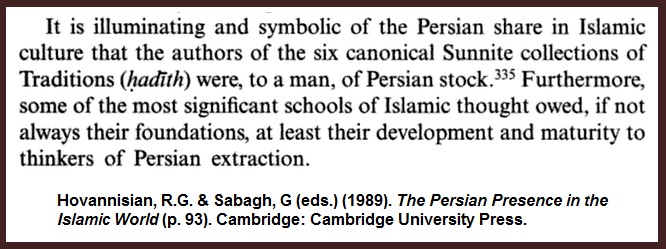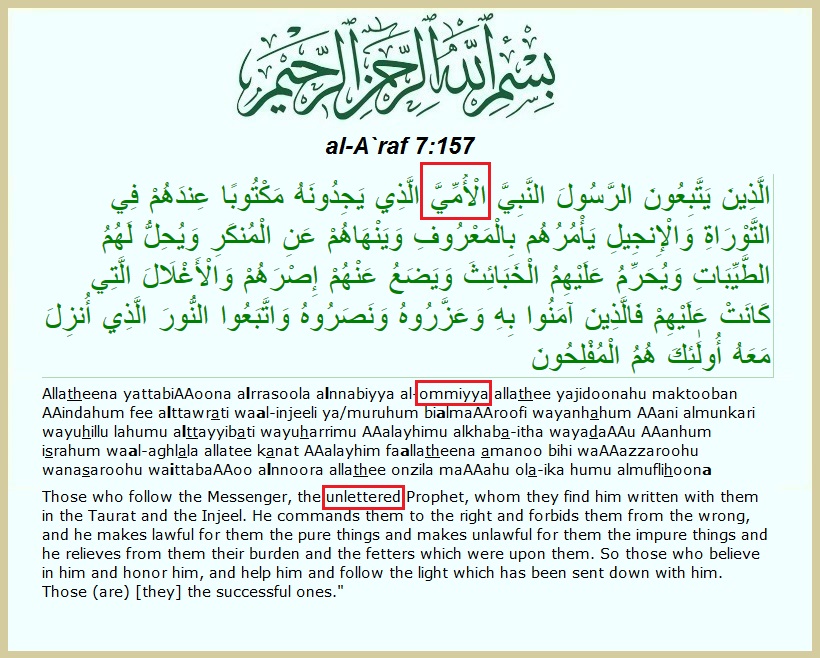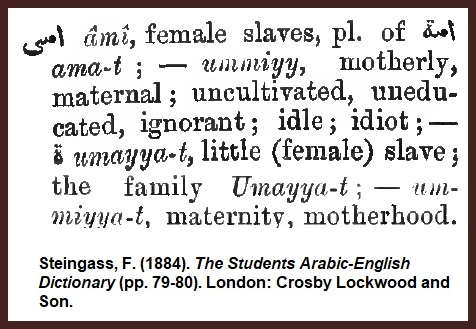**Arabic**
Contemporary Islam is very different from Islam in its earliest form. A primary reason is Qur’an has been misinterpreted due to changes in the Arabic language.
The modern day Muslim can typically recite many verses of Qur’an in Arabic, some the entire book from memory, but most have limited comprehension of the meanings of Qur’an, because there are significant differences between modern standard Arabic and classical Arabic. Most Muslims get their understanding of Qur’an and of Islam from sectarian sources, all of which rely heavily on hadith.
**Hadith**
Islam was also distorted by the introduction of collections of hadith, which were written primarily by non-Arabs over 150 years after Muhammad’s death (632 CE).
“Of those who formalized the shaping of Islam and provided it with both the theological and legal foundations, most of the eminent thinkers and scholars have been non-Arabs”. (Zakaria, 2004, p. 391)
“…The authors of the six canonical Sunnite collections of Traditions (hadith) were, to a man, of Persian stock.” (Hovannisian & Sabagh, 1989, p. 93)

The authors of the six canonical Sunnite collections of hadith lived at least two centuries after Muhammad’s death (632 C.E.).

Prominent Shia hadith collectors lived many centuries later.
“Persian literature gave an entirely alien complexion to the Arabic linguistics.” (Ahmed 2012, p. 3)
**Prophecy Fulfilled: Hadith Will Mislead and Bring Ridicule to Islam**
Qur’an prophetically warned that hadith would mislead people from the correct knowledge of Islam, and bring ridicule to it.
Some “authentic” (sahih) hadith are insulting to human intelligence.

There are “authentic” hadith that contradict one another, including an “authentic” hadith that forbids the writing of hadith.
Each of the two major sects of Muslims, Sunni and Shia, rejects the authenticity of the other’s hadith. It is known among Muslim scholars that large scale forgery of hadith occurred for political and factional reasons.
One hadith fabricator confessed, “I fabricated 4000 hadiths for you in which I made you fast when you should have not, and made unlawful what was lawful, and made lawful what was unlawful.” (Raof 2010)
**Assassination of Muhammad’s Character**
In addition to supporting factional and political agendas, hadith were also fabricated in order to assassinate Muhammad’s character.

The allegation that Muhammad married his wife Aisha when she was six years old, and consummated the marriage when she was nine years old, comes from hadith, and is in no way supported by Qur’an, or by any credible sources.

**Muhammad’s Literacy**
The claim that Muhammad was illiterate also originated in hadith, and is contradicted by Qur’an.
The Arabic word ummiyya (also transliterated as ommiyya) has been misdefined as, illiterate/unlettered.
Some scholars suppose ummyy to mean a Meccan (Makkian) or an Arab.

Ummi (Ummyy) and Umayyad share the same root, among its meanings are family, tribe, and kinsfolk.
Verse 7:157 is referring to Muhammad’s relationship to the Umayyad clan from Mecca, not to his literacy skills. During and after the lifetime of Muhammad, Umayyads held prominent positions in the early Islamic Empire . (See more in the next section of this chapter).

Furthermore, modern scholars have confirmed that a manuscript discovered in 1947 is an authentic letter written by Muhammad, which he sent to the Byzantine Emperor Heraclius.
Muhammad sent envoys with his written invitation to Islam to the other powerful world leaders. In China, his invitation to Islam was well received, and in the year 629, a mosque was built in Canton.
Pictured below, mosque and minaret built in Canton, China (c. 629 CE).
**Umayyad Prominence in Early Islam**
“He [Muhammad] appointed individuals from the Umayyad clan to three fourth[s] of the [governor and agent] positions although many Hashimites were qualified to [a] certain extent to hold such positions.” (Souaiaia, 2001, p. 66)
“. . . The Prophet had in fact used members of the Umayyad clan for political office, but never any Hashemites.” (El-Hibri 2010, p. 357)
Like Muhammad, the Umayyads were descendants of the biblical Ishmael (Ismail).
The Abbasids were also related to Muhammad, and descendants of Ishmael. They were descendants of the Hashemites.

In the first century of Islam, only those born of a free Ishmaelite-Arabian father and mother were eligible for the khalifate.

The Umayyads kept their Ishmaelite-Arabian bloodline pure by only allowing the children of legal wives of pure blood, to inherit the throne.
The Abbasids preference for concubines and harems destroyed the principal of racial purity. They were therefore denied the khalifate until after they had overthrown the Umayyad dynasty (see more, chapter 6).
**The Ishmaelite Khalif’s **
Following Muhammad’s death, Abu Bakr from the Taym clan of the tribe of Quraish became the first khalif.
Having an in-depth knowledge of the lineage of Quraish tribesmen in particular and Arabs in general, Abu Bakr was perhaps the most knowledgeable genealogist of his time.

The second khalif was Umar ibn al-Khattab (Omar I). The following genealogical chart of the tribe of Quraish shows, both Abu Bakr and Umar ibn al-Khattab were also descendants of Ishmael.
Umar ibn al-Khattab was the maternal grandfather of the Umayyad Dynasty’s ninth khalif, his namesake Umar ibn ‘abd al-Aziz (Omar II).
The third khalif, Uthman ibn Affan, was Muhammad’s son-in-law and a leader of the Umayyad family. Following the assassination of Uthman’s successor, Ali, the Umayyad Dynasty reigned exclusively over the entire Islamic empire from 661 CE until 750 CE, when they were overthrown by the Abbasids, in a coup engineered by Persians. (Latif, 2019, p. 3) In 756 the surviving Umayyads established an emirate independent of the Abbasids on the Iberian peninsula. (Barton 2003, p. 28)
Persians were powerfully influenced by their prejudice against khalif Umar ibn al-Khattab, who led the Arabian army that conquered Persia. Persian Shia’s preferred Ali, partly because his son Hussein married into the House of Sassan, which had reigned over Persia for more than four centuries.

Falsely colored, distorted, and fabricated tradition tarnished the image of the Umayyads (Ommeyads), and exalted the Abbasids and Ali.
**No Mention of Jesus in Qur’an**
Jesus has been wrongly conflated with Isa (AAeesa) ibn Maryam (son of Mary) in Qur’an.
In Surah 19:28, Isa’s mother Maryam (Mary) is identified as “sister of Aaron”. Aaron is the older brother of Moses.
Surah 66:12 further identifies Maryam (Mary) as daughter of Imran, who is one and the same man as Amram in Torah, father of Aaron and Moses.
The Koran itself confirms the brother-sister relationship between Mary and Aaron by saying that they had the same father, Imram. (Osman 2004)
In Qur’an, chapter 5, verses 44-46, say, Isa came on the footsteps of the Torah (i.e. books of Moses). The meaning of the Arabic word “atharihim” in 5:46 is, following near upon him, or near after him, as though treading in his footsteps. (Lane 1863, p.19) Jesus of the New Testament is said to have lived in 1st century CE, approximately 1600 years after Imran (Amram), Aaron, and Maryam.

The Book of Numbers 26:59 (AKVJ) confirms, Aaron, Moses, and Miriam (Maryam) are the children of Amram (Imran), all of whom lived during 2nd millennium BCE (see Chapter 2).
Muhammad, descendant of Ishmael son of Abraham, through whom Biblical prophecy was fulfilled, acknowledged as “a messenger of God” by his contemporary Heraclius, the Byzantine emperor, (Thomas & Mallett 2010, 30) made no mention of Jesus Christ. Jesus is not Isa ibn Maryam.
**Deen**
The result of these innovations and deviations is, lost sight of Islam’s intended message of freedom from oppression and state building, which was replaced with a dogmatic and ritualized religion.
Qur’an refers to Islam as “deen”, which is commonly misdefined as “religion”.
In Qur’an, surah Yusuf (12), ayat 76, deen means, law.

Deen requires the use of reasoning and discourages blind belief.
Islam being a collective system of life is, in fact, a challenge to religion.






































Religion is usually a combination of law and culture. There is nothing wrong with this term. System sounds more modern but not necessarily more right. And many prominent Muslim scholars have been non-Arabs, this does not take away from their work and it doesn’t mean that they had not mastered Classical Arabic. The hadeeth are a problem because they are called authentic when they are not, and Muslims allow them to be interpreted in ways that contradict the Quran, not just because they are outside of the Qur’an.
LikeLike
Anwar
I apologize for my late response. I just realized you left this comment. Your comment does not consider this work as a whole. Islam is the fulfillment of the Biblical promise (Genesis 17:20) from Allah of a great Ismailite nation (see Chapter 4 of this website). Non-Arabians, specifically Persians, violently overthrew the Umayyad Khalifate (who were Ismailites) in 750 AD (see Chapter 6 of this website), added elements of Persian culture to Islam (such as Zoroastrianism), reinterpreted Qur’an through hadith, and changed the meaning of many key Arabic words to fit their new interpretation. This new interpretation hides the fact that Islam is the fulfillment Allah’s promise to the descendants of Ismail, who alone, were intended to be the stewards Islam.
Islam is “deen” not “religion”. “Deen” refers to the laws, customs, and practices passed down from Ibrahim to his descendants (See Lane in Chapter 4). Prior to Islam, Ismailites had forgotten their deen, largely because they followed unwritten pre-Mosaic laws. Islam perfected their deen through Qur’an. Islam in its original form was a system (deen) for Ismailites to overthrew oppressive societies, liberate the oppressed (See Chapter 6), and to install a righteous Islamic government in its place (Jannah on Earth). Islam is not a religion concerned with individual salvation through the adherence of ritual acts.
LikeLike